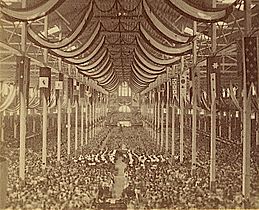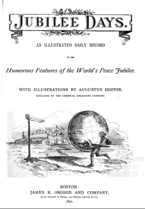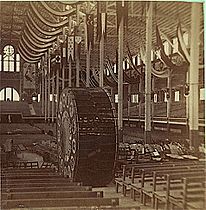World's Peace Jubilee and International Musical Festival facts for kids
The World's Peace Jubilee and International Musical Festival was a huge music event held in Boston, Massachusetts, in 1872. It lasted about 18 days and was led by Patrick Sarsfield Gilmore, a famous bandleader. This special festival celebrated the end of the Franco-Prussian War, a big conflict in Europe.
Building a Giant Stage
For this very popular event, a huge building called a "coliseum" was built in the Back Bay area of Boston. Architect William G. Preston designed it. It could hold 100,000 people and cost half a million dollars to build, which was a lot of money back then! Inside, there was a giant pipe organ, 43 feet tall.
The festival opened on June 17, 1872. About 15,000 people came to watch. Phillips Brooks, a well-known speaker, gave a prayer. Boston's mayor, William Gaston, and Nathaniel Prentice Banks also gave speeches. Sadly, the building was so big and noisy from workers still finishing up that many people could not hear the speeches clearly.
Amazing Music and Performers
Many talented musicians came to perform at the Jubilee. Bands from different countries, like the Grenadier Guards from London, the Garde republicaine from Paris, and a band from Berlin, all played. Famous musicians like Johann Strauss II, known as the "waltz king," and German songwriter Franz Abt were also there.
One concert was especially huge! It featured a performance of Verdi's opera Il Trovatore. A massive orchestra with 2,000 musicians played, led by Johann Strauss, Jr., and 100 assistants. A choir of 20,000 singers, who came from all over the United States, joined in. Carl Zerrahn directed this giant choir. An American composer named Dudley Buck even wrote a new song, Festival Hymn: Peace and Music, just for this event.
The Fisk Jubilee Singers also performed. They were an African American group from Fisk University. This was a very important moment because it was the first time Black singers were part of such a big national music show. Johann Strauss played his violin, and everyone watched him closely. People cheered loudly after his waltz, and he had to play it again! Other performers included pianist Franz Bendel, singer Madame Rudersdorff, the United States Marine Band, and Arabella Goddard.
News and Challenges
The Jubilee was very modern for its time. It had special "Press and Telegraph Rooms" for reporters. These rooms had everything the press needed to send news quickly to all parts of the world.
Even with all the excitement, the festival had money problems. Not as many people attended as expected, and building the coliseum cost more than planned. Some people, like writer John Dwight, did not enjoy it much. He wrote that it felt like a "heavy, brooding nightmare" was finally over. However, the World's Peace Jubilee was a huge event that inspired many similar music festivals in the years that followed.
Images for kids







